
Mr Butler, your pants are on fire. An open letter
Posted on December 21, 2023 By Colin
SORRY TO BE BLUNT MR BUTLER, but your pants are on fire. The talking points you keep repeating about youth vaping are simply not evidence-based and are patently wrong.
This blog challenges seven of your most often repeated falsehoods. Previous fact checks on your past porkies are here, here and here.
1. Vaping and the Tobacco Industry
“What the tobacco industry has done here is tried to find a product that will recruit a whole new generation of nicotine addicts” (link)
FALSE. This is an attempt to discredit vaping by associating it with the hated tobacco industry. However, the tobacco industry has absolutely no role in youth vaping in Australia.
None of the disposable vapes used by young people are made by tobacco companies. All of these (IGET, HQD and Gunnpod) are imported illegally from China by black market operators. Only a handful of tobacco company vapes are sold in Australia, and these are only available to adult smokers from pharmacies with a doctor’s prescription
2. Gateway to Smoking
“Vaping is a gateway to smoking” (link)
FALSE. The evidence contradicts this. The gateway theory predicts that vaping will increase smoking rates in young people. However, we are seeing the opposite of this in Western countries where vaping is diverting young people away from smoking and reducing smoking overall. Current youth smoking in Western countries ranges from 1-3%.
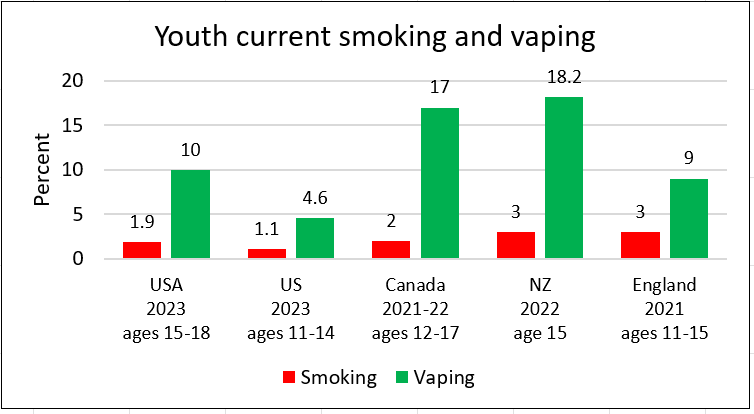
You often say that young people who try vaping are 3 times more likely to become smokers, implying that vaping caused them to take up smoking. However, young people who try vaping are simply more likely to take other risks such as smoking, binge drinking, drink driving and using drugs. They they share risk factors that lead to both vaping and smoking ('common liability').
This this does not mean that vaping caused them to take up smoking as you falsely imply
Please read my blog for a full review of the evidence on the 'gateway theory'.
3. Nicotine Dependency
“Vaping is creating a whole new generation of nicotine dependency in our community” (link)
FALSE and ALARMIST. Most vaping by young non-smokers is experimental, occasional and short term. Frequent vaping is needed to develop nicotine dependence.
Two recent peer-reviewed Australian studies (Watts 2022; Gardner 2023) found that <2% of 14-17-year-olds who have never smoked, vape nicotine frequently enough (at least weekly) to be at-risk of developing nicotine dependence.
This is clearly not a whole new generation!
Nicotine dependence can lead to withdrawal causing short-term symptoms such as irritability, restlessness, anxiety, difficulty concentrating and depression. These symptoms are unpleasant but not serious. Please don't create a false panic about this.
But don't just take my word for it. A review by 15 eminent former presidents of the Society for Research on Nicotine and Tobacco concluded:
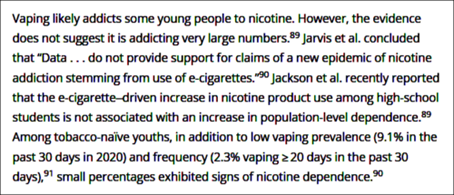
4. Youth vaping rates
“The latest data, from the first quarter of 2023, shows that about one in seven 14- to 17-year-olds and one in five 18- to 24-year-olds are current vapers” (link)
MISLEADING. This statement exaggerates the real prevalence of problematic vaping. You refer to ‘current’ vaping, which means having one puff or more in the last month. However, many young people vape only once or twice, or every now and then and most are at little or no risk of harm.
What is important is how many non-smoking youth vape frequently, as this is the group most at risk from new and potentially harmful inhaled chemicals. Australian research (Watts 2022, Gardner 2023) found that less than 2% of 14-17-year-old Australians vape nicotine ‘frequently’ (weekly or more) but have never smoked. This result is similar to other countries where frequent or daily youth vaping by non-smokers is generally <2%. More here.
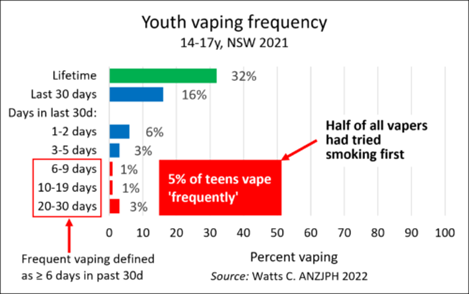
5. Public Health Threat
“Vaping poses a major threat to Australia’s success in tobacco control” (link)
FALSE. Rather than being a threat, vaping is a huge opportunity to improve tobacco control and public health across the whole population.
The main public health priority is smoking, not vaping, the leading preventable cause of death and illness for the parents and grandparents of the young people you are so concerned about. Countries where vaping is readily available have seen an accelerated decline in adult and youth smoking rates and vaping is a major contributor to this. Vaping is the most effective and most popular quitting aid available. However, in Australia, the current adult smoking rate has flatlined over the last 5 years. This is really embarrassing.
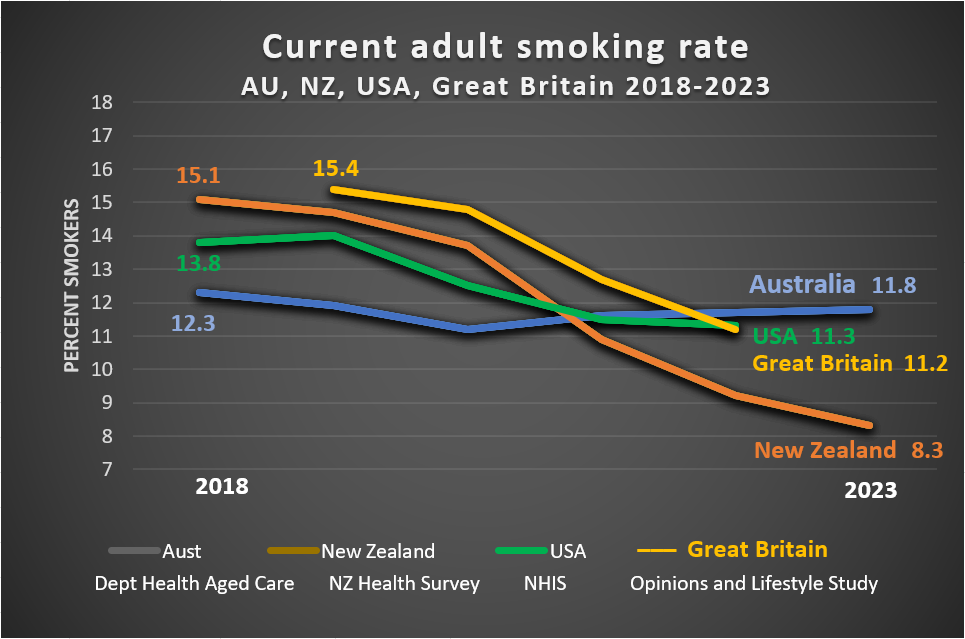
Young people should not smoke or vape. However, our recent Evidence Review found that youth vaping carries relatively minor health risk.
Modelling studies can estimate the likely public health effect of vaping. An Australian study estimated that 104,200 smoking deaths and 2.05 million life-years lost would be averted during 2017–80 if vaping was made readily available.
6. Increasing Youth Smoking Rates
“The only cohort in the population in Australia where smoking rates are actually on the rise is the youngest members of our community (under 25s)” (link)
FALSE. You claim that vaping is leading to an increase in smoking by Australia youth. This is based on one study that found that smoking by 14-17-year-olds increased in Australia over the last 4 years and is now a staggering 12.8%.
Firstly, this result is not credible due to the wild monthly fluctuations in the survey and small numbers of youth surveyed (more here).
Secondly, if the results are valid, how do you explain that youth smoking rates are only 1-3% in other Western countries with similar vaping rates to Australia? Could this be a direct result of your flawed policy on vaping? By misinforming young people that vaping is as harmful as smoking, are you telling them they may as well smoke?
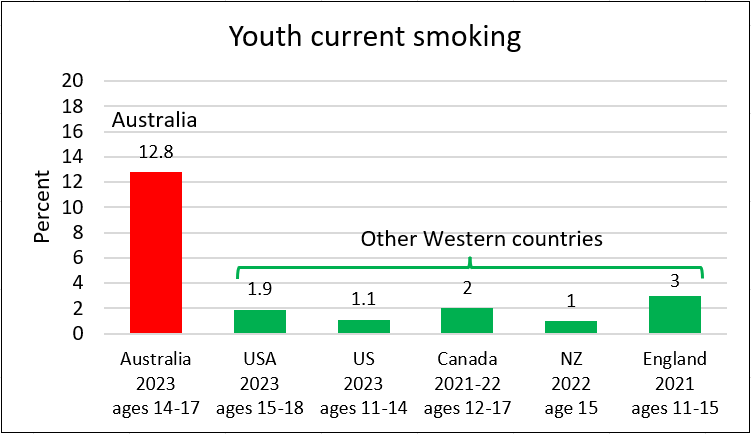
Results not consistent with other research
Furthermore, these results are not consistent with other Australian and international research which shows that smoking rates are declining faster in young people (who have the highest vaping rates) than in the rest of the population
- In New South Wales, the decline in smoking in the 16-24-year-age-group has been faster than in any other age group as vaping rates have increased.
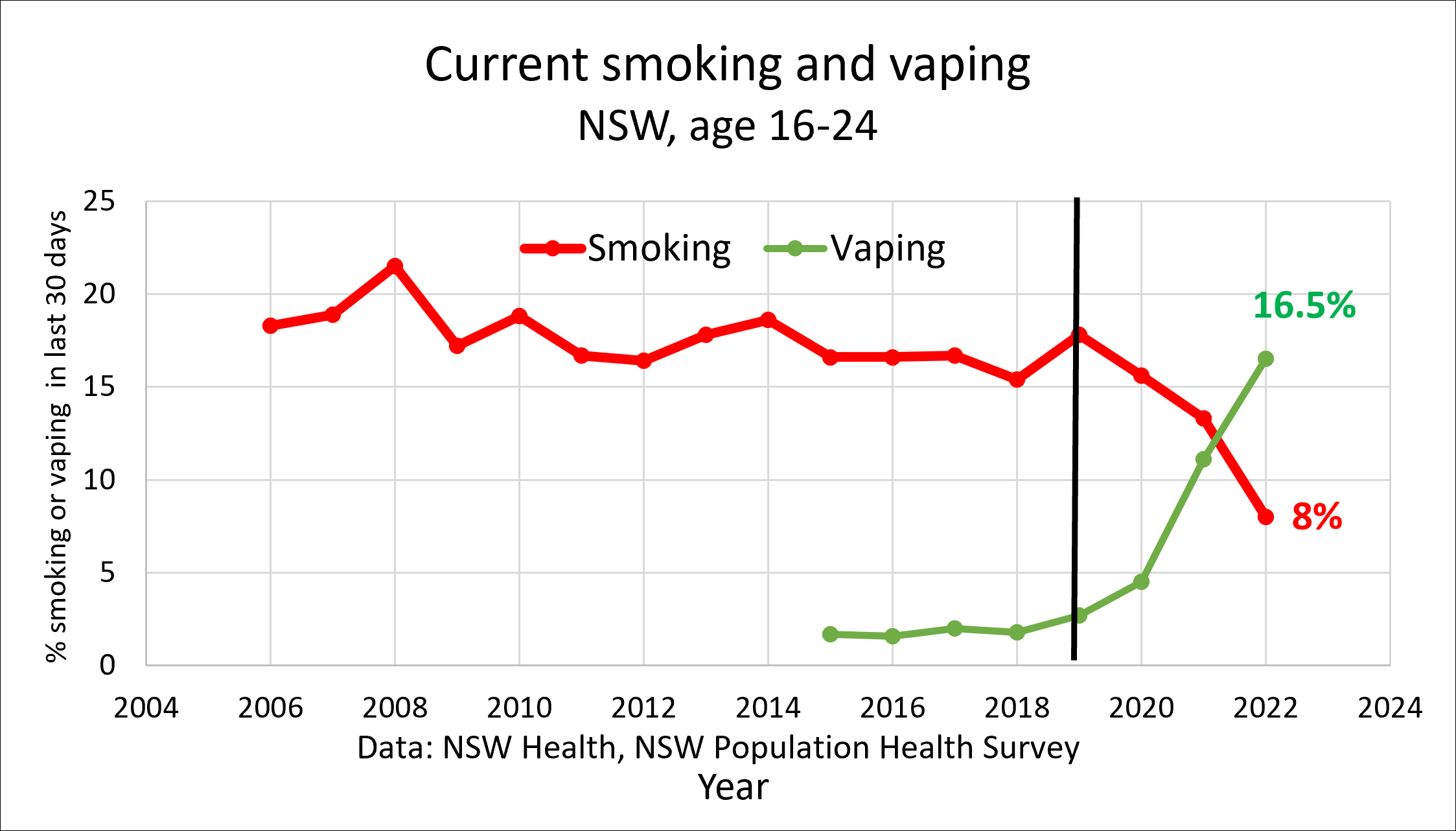
- In the recent 2022 Australian National Health Survey, the decline in smoking from 2011-2022 was fastest in the younger age groups that had the highest vaping rates.
- In New Zealand. Between 2019-22 there were very substantial declines in smoking in 15-24-year-olds, coinciding with a rapid increase in vaping. Only 1.1% of 15-17 year and 8.2% of 18-24-year-olds smoke daily.
- In the US, youth smoking has declined faster since vaping became available and has almost disappeared. Only 1.9% of high schoolers (grades 9-12) now smoke. Also a recent study found that the 18-34 year age group had the highest vaping rate and the fastest decline in smoking of any age group.
7. Marketing to Youth
“This is a product that is deliberately and cynically marketed to them (youth)” (link)
These products are not available from legitimate, legal providers. They are marketed and sold by the black market that your policy has created. The black market is targeting youth with child-friendly packaging and flavours.
The solution is to eliminate the black market by replacing it with a legal, regulated market. Please click here to find out how vaping should be regulated to avoid this problem.
The black market is a direct result of the current restrictive regulations and has flourished since your prescription model was introduced.
Conclusion and advice
Public health policy should be evidence-based. However, your crusade against vaping is built on misinformation and bad advice from your inner circle of anti-vaping advisers.
Opposing vaping may be a politically successful strategy in the short term. However, it is a public health disaster for which you will be held accountable
I am happy to meet with you anytime, anywhere to discuss the evidence. You can contact me on 0415 976 783 or via email, mendel@bigpond.net.au.